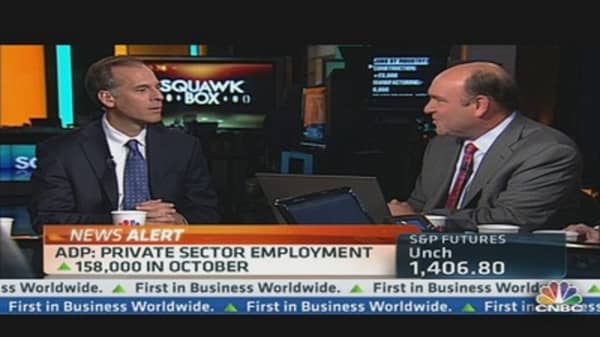The private sector created a better-than-expected 158,000 jobs in October, while jobless claims edged lower and productivity rose about as much as expected.
A day after the firm sharply lowered its original count for September, ADP and Macroeconomic Advisors, working now with Moody's Analytics, said the service sector once again had a big month for job creation.
Services comprised most of the October total, ringing up 144,000 jobs while the goods-producing sector made up the balance at 14,000.
One change in recent trends was that large businesses were the leading job-creators, accounting for 81,000 of the new positions.
The ADP changeover in the way it was handling its monthly job count created a stir Wednesday when the firm said the original 162,000 new positions reported for September actually came down to 88,200 under the new methodology. (Read More: New ADP Count Slashes Job Creation for September)
That number was changed again Thursday, revised mildly upward to 114,000, close to the government's number for the same month.
"This is very consistent with the job growth we've been getting for the last three months, 12 months, 24 months," Moody's economist Mark Zandi told CNBC.
ADP joined forces with Moody's to compile the report after it had been criticized for regular disparities with the Labor Department's nonfarm payroll report, which follows the ADP count. The new methodology includes a broader count that increases the amount of industries and the total firms included in the sample size.
Economists expect the payroll report to show 125,000 new positions created when folding in government jobs to the count.
Jobless Claims Slip
Elsewhere in the economy, the number of Americans filing new claims for unemployment benefits fell last week, a sign the labor market's slow recovery was gaining traction.
Initial claims for state unemployment benefits dropped 9,000 to a seasonally adjusted 363,000, the Labor Department said on Thursday. That was below the median forecast in a Reuters poll of 370,000. (Read More: America's Highest Paying Jobs)
An analyst from the department said New Jersey and Washington, D.C., did not turn in data due to the mammoth storm Sandy, which hit the Northeast earlier this week. The Labor Department estimated results for the state and for the nation's capital.
Economists have said the storm could lead to volatility in jobless claims over the coming weeks.
There were no signs the storm had any impact on last week's data, the Labor Department analyst said.
The four-week moving average for jobless claims, which smoothes out volatility, dropped 1,500 to a 367,250. Economists generally think a reading below 400,000 points to an increase in employment.
The country's weak labor market has dominated its presidential campaign and Friday's employment report will give the last jobless rate before Tuesday's election. Polls show a very tight race between President Barack Obama and Republican challenger Mitt Romney. (Read More: Presidential Campaigns Go Full Tilt After Storm Break)
The U.S. economy has recently shown some signs of health, with consumers spending more freely and home construction picking up. But business investment sank in the third quarter, a sign companies lack confidence in the strength of the economic recovery.
The prior week's estimate for jobless claims was revised slightly higher to show 3,000 more applications than previously reported.
Continuing claims for jobless benefits rose 4,000 in the week ended Oct. 20 to a seasonally adjusted 3.263 million, the Labor Department said.
Productivity Up
U.S. nonfarm productivity increased at a modest pace in the third quarter, giving little sign that businesses are poised to ramp up hiring significantly.
Productivity, which measures hourly output per worker, increased at a 1.9 percent annual rate, the Labor Department said on Thursday.
Many economists would read a drop in productivity as a sign that companies are closer to maxing out production with existing staff and would have to boost hiring.
But the third-quarter reading matched the revised reading for the prior three-month period.
Businesses emerged from the 2007-09 recession lean and are showing little urgency to increase hiring, relying on their existing workforce to meet production.
Economists had expected third-quarter productivity to rise at a 1.6 percent rate.
Output increased at a 3.2 percent rate in the third quarter.
During the country's sharp economic downturn, productivity grew rapidly as companies cut costs, particularly wage bills. Productivity growth slowed sharply in 2011 and fell in the first quarter of 2012, but has since snapped back to a 1.9 percent growth rate.
The report showed unit labor costs fell at a 0.1 percent rate in the third quarter, missing analysts' expectations of a 1 percent increase.





